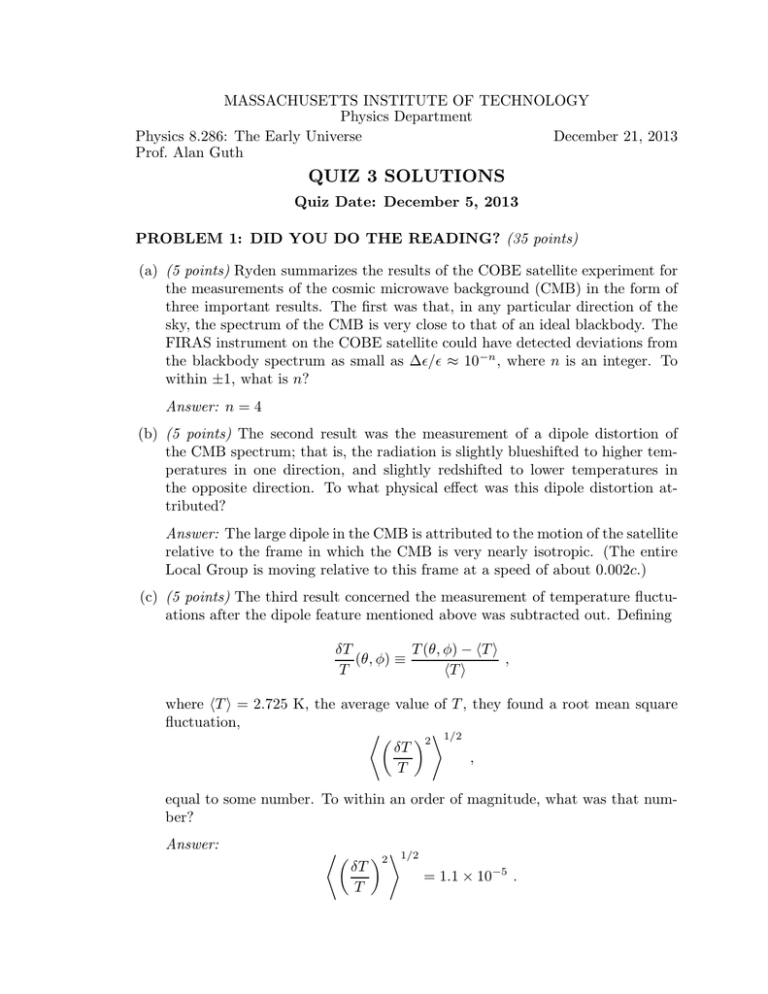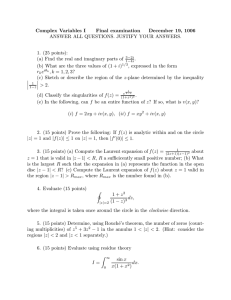MASSACHUSETTS INSTITUTE OF TECHNOLOGY Physics Department Physics 8.286: The Early Universe
advertisement

MASSACHUSETTS INSTITUTE OF TECHNOLOGY Physics Department Physics 8.286: The Early Universe December 21, 2013 Prof. Alan Guth QUIZ 3 SOLUTIONS Quiz Date: December 5, 2013 PROBLEM 1: DID YOU DO THE READING? (35 points) (a) (5 points) Ryden summarizes the results of the COBE satellite experiment for the measurements of the cosmic microwave background (CMB) in the form of three important results. The first was that, in any particular direction of the sky, the spectrum of the CMB is very close to that of an ideal blackbody. The FIRAS instrument on the COBE satellite could have detected deviations from the blackbody spectrum as small as ∆/ ≈ 10−n , where n is an integer. To within ±1, what is n? Answer: n = 4 (b) (5 points) The second result was the measurement of a dipole distortion of the CMB spectrum; that is, the radiation is slightly blueshifted to higher temperatures in one direction, and slightly redshifted to lower temperatures in the opposite direction. To what physical effect was this dipole distortion attributed? Answer: The large dipole in the CMB is attributed to the motion of the satellite relative to the frame in which the CMB is very nearly isotropic. (The entire Local Group is moving relative to this frame at a speed of about 0.002c.) (c) (5 points) The third result concerned the measurement of temperature fluctuations after the dipole feature mentioned above was subtracted out. Defining δT T (θ, φ) − T (θ, φ) ≡ , T T where T = 2.725 K, the average value of T , they found a root mean square fluctuation, 1/2 2 δT , T equal to some number. To within an order of magnitude, what was that number? Answer: δT T 2 1/2 = 1.1 × 10−5 . 8.286 QUIZ 3 SOLUTIONS, FALL 2013 p. 2 (d) (5 points) Which of the following describes the Sachs-Wolfe effect? (i) Photons from fluid which had a velocity toward us along the line of sight appear redder because of the Doppler effect. (ii) Photons from fluid which had a velocity toward us along the line of sight appear bluer because of the Doppler effect. (iii) Photons from overdense regions at the surface of last scattering appear redder because they must climb out of the gravitational potential well. (iv) Photons from overdense regions at the surface of last scattering appear bluer because they must climb out of the gravitational potential well. (v) Photons traveling toward us from the surface of last scattering appear redder because of absorption in the intergalactic medium. (vi) Photons traveling toward us from the surface of last scattering appear bluer because of absorption in the intergalactic medium. (e) (5 points) The flatness problem refers to the extreme fine-tuning that is needed in Ω at early times, in order for it to be as close to 1 today as we observe. Starting with the assumption that Ω today is equal to 1 within about 1%, one concludes that at one second after the big bang, |Ω − 1|t=1 sec < 10−m , where m is an integer. To within ± 3, what is m? Answer: m = 18. (See the derivation in Lecture Notes 8.) (f) (5 points) The total energy density of the present universe consists mainly of baryonic matter, dark matter, and dark energy. Give the percentages of each, according to the best fit obtained from the Planck 2013 data. You will get full credit if the first (baryonic matter) is accurate to ±2%, and the other two are accurate to within ±5%. Answer: Baryonic matter: 5%. Dark matter: 26.5%. Dark energy: 68.5%. The Planck 2013 numbers were given in Lecture Notes 7. To the requested accuracy, however, numbers such as Ryden’s Benchmark Model would also be satisfactory. (g) (5 points) Within the conventional hot big bang cosmology (without inflation), it is difficult to understand how the temperature of the CMB can be correlated at angular separations that are so large that the points on the surface of last scattering was separated from each other by more than a horizon distance. Approximately what angle, in degrees, corresponds to a separation on the surface last scattering of one horizon length? You will get full credit if your answer is right to within a factor of 2. Answer: Ryden gives 1◦ as the angle subtended by the Hubble length on the surface of last scattering. For a matter-dominated universe, which would be a good model for our universe, the horizon length is twice the Hubble length. Any number from 1◦ to 5◦ was considered acceptable. 8.286 QUIZ 3 SOLUTIONS, FALL 2013 p. 3 PROBLEM 2: FREEZE-OUT OF MUONS (25 points) See the solutions to Problem Set 7, Problem 2 (2013). PROBLEM 3: THE EVENT HORIZON FOR OUR UNIVERSE (25 points) (a) In a spherical pulse each light ray is moving radially outward, so dθ = dφ = 0. A light ray travels along a null trajectory, meaning that ds2 = 0, so we have ds2 = −c2 dt2 + a2 (t) dr 2 = 0 . from which it follows that dr c =± . dt a(t) (3.1) (3.2) We are interested in a radial pulse that starts at r = 0 at time t = t0 , so the limiting value of r is given by rmax = ∞ t0 c dt . a(t) (3.3) (b) Changing variables of integration to x= a(t) , a(t0 ) (3.4) the integral becomes rmax = 1 ∞ c dt c dx = a(t) dx a(t0 ) 1 ∞ 1 dt dx , x dx (3.5) where we used the fact that t = t0 corresponds to x = a(t0 )/a(t0 ) = 1. As given to us on the formula sheet, the first-order Friedmann equation can be written as dx x = H0 Ωm,0 x + Ωrad,0 + Ωvac,0 x4 + Ωk,0 x2 . (3.6) dt Using this substitution, rmax c = a(t0 )H0 ∞ 1 dx , Ωm,0 x + Ωrad,0 + Ωvac,0 x4 (3.7) 8.286 QUIZ 3 SOLUTIONS, FALL 2013 p. 4 where we have used Ωk,0 = 0, since the universe is taken to be flat. (c) To find the value of the redshift for the light that we are presently receiving from coordinate distance rmax , we can begin by noticing that the time of emission te can be determined by the equation which implies that the coordinate distance traveled by a light pulse between times te and t0 must equal rmax . Using Eq. (3.2) for the coordinate velocity of light, this equation reads t0 c (3.8) dt = rmax . te a(t) The “half-credit” answer to the quiz problem would include the above equation, followed by the statement that the redshift zeh can be determined from z= a(t0 ) −1 . a(te ) (3.9) The “full-credit” answer is obtained by changing the variable of integration as in part (b), so Eq. (3.8) becomes 1 c dt dx rmax = xe a(t) dx (3.10) 1 1 dt c = dx , a(t0 ) xe x dx where xe is the value of x corresponding to t = te . Then using Eq. (3.6) with Ωk,0 = 0, we find rmax c = a(t0 )H0 1 xe dx . Ωm,0 x + Ωrad,0 + Ωvac,0 x4 (3.11) To complete the answer in this language, we use z= 1 −1 . xe (3.12) Eqs. (3.11) and (3.12) constitute a full answer to the question, but one could go further and replace rmax using Eq. (3.7), finding 1 ∞ dx Ωm,0 x + Ωrad,0 + Ωvac,0 x4 1 dx . = Ωm,0 x + Ωrad,0 + Ωvac,0 x4 xe (3.13) 8.286 QUIZ 3 SOLUTIONS, FALL 2013 p. 5 In this form the answer depends only on the values of ΩX,0 . You were of course not asked to evaluate this formula numerically, but you might be interested in knowing that the Planck 2013 values Ωm,0 = 0.315, Ωvac,0 = 0.685, and Ωrad,0 = 9.2 × 10−5 lead to zeh = 1.87. Thus, no event that is happening now (i.e., at the same value of the cosmic time) in a galaxy at redshift larger than 1.87 will ever be visible to us or our descendants, even in principle. PROBLEM 4: BEHAVIOR OF Ω IN A UNIVERSE DOMINATED BY MYSTERIOUS STUFF (15 points) (a) From the Friedmann equation, H2 = 8π kc2 Gρ − 2 , 3 a and the definition of ρc , H2 = 8π Gρc , 3 we have 8π kc2 8π Gρ − 2 = Gρc , 3 3 a which can be rearranged to give ρ − ρc = 3kc2 . 8πGa2 Dividing both sides by ρ we find ρ − ρc Ω−1 3kc2 = . = ρ Ω 8πGa2 ρ (The middle expression above is obtained from the expression on the left by multiplying both the numerator and the denominator by 1/ρc .) Now multiply both the numerator and denominator of the expression on the right by T 2 , recognizing that aT is approximately constant. We then have Ω−1 T2 =A , Ω ρ where A= 3kc2 . 8πG(aT )2 8.286 QUIZ 3 SOLUTIONS, FALL 2013 p. 6 (b) Combining the above equation with our knowledge that T ∝ 1/a and ρ ∝ 1/a5 , we have immediately that Ω−1 1/a2 ∝ ∝ a3 . Ω 1/a5 To determine how a depends on time, we can solve the Friedmann equation for a flat universe dominated by mysterious stuff: 2 ȧ const = a a5 =⇒ Thus a3/2 da = √ da = dt √ const . a3/2 const dt and then 2 5/2 √ a = const t , 5 where the constant of integration is set to zero by using the convention that a = 0 when t = 0. Thus a ∝ t2/5 , and then Ω−1 ∝ a3 ∝ t6/5 . Ω MIT OpenCourseWare http://ocw.mit.edu 8.286 The Early Universe Fall 2013 For information about citing these materials or our Terms of Use, visit: http://ocw.mit.edu/terms.



